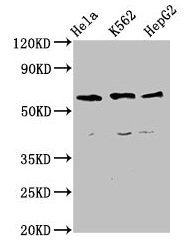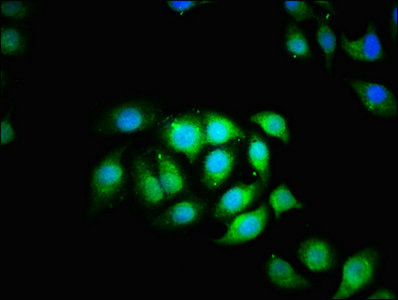CCT5 Antibody
-
货号:CSB-PA004862EA01HU
-
规格:¥440
-
促销:
-
图片:
-
Western Blot
Positive WB detected in: Hela whole cell lysate, K562 whole cell lysate, HepG2 whole cell lysate
All lanes: CCT5 antibody at 4µg/ml
Secondary
Goat polyclonal to rabbit IgG at 1/50000 dilution
Predicted band size: 60, 50 kDa
Observed band size: 60 kDa -
Immunofluorescence staining of A549 cells with CSB-PA004862EA01HU at 1:166, counter-stained with DAPI. The cells were fixed in 4% formaldehyde, permeabilized using 0.2% Triton X-100 and blocked in 10% normal Goat Serum. The cells were then incubated with the antibody overnight at 4°C. The secondary antibody was Alexa Fluor 488-congugated AffiniPure Goat Anti-Rabbit IgG(H+L).
-
-
其他:
产品详情
-
产品名称:Rabbit anti-Homo sapiens (Human) CCT5 Polyclonal antibody
-
Uniprot No.:P48643
-
基因名:CCT5
-
别名:CCT 5 antibody; CCT epsilon antibody; CCT-epsilon antibody; CCT5 antibody; CCTE antibody; CCTepsilon antibody; Chaperonin containing T-complex polypeptide 1; subunit 5 antibody; Chaperonin containing TCP 1 epsilon antibody; Chaperonin containing TCP 1 subunit 5 antibody; Chaperonin containing TCP 1 subunit 5 epsilon antibody; Chaperonin containing TCP1 epsilon antibody; Chaperonin containing TCP1 subunit 5 antibody; Chaperonin containing TCP1 subunit 5 epsilon antibody; KIAA0098 antibody; T complex protein 1 epsilon subunit antibody; T complex protein 1 subunit epsilon antibody; T-complex protein 1 subunit epsilon antibody; TCP 1 epsilon antibody; TCP-1-epsilon antibody; TCP1epsilon antibody; TCPE antibody; TCPE_HUMAN antibody
-
宿主:Rabbit
-
反应种属:Human
-
免疫原:Recombinant Human T-complex protein 1 subunit epsilon protein (1-270AA)
-
免疫原种属:Homo sapiens (Human)
-
标记方式:Non-conjugated
本页面中的产品,CCT5 Antibody (CSB-PA004862EA01HU),的标记方式是Non-conjugated。对于CCT5 Antibody,我们还提供其他标记。见下表:
-
克隆类型:Polyclonal
-
抗体亚型:IgG
-
纯化方式:>95%, Protein G purified
-
浓度:It differs from different batches. Please contact us to confirm it.
-
保存缓冲液:Preservative: 0.03% Proclin 300
Constituents: 50% Glycerol, 0.01M PBS, pH 7.4 -
产品提供形式:Liquid
-
应用范围:ELISA, WB, IF
-
推荐稀释比:
Application Recommended Dilution WB 1:500-1:5000 IF 1:50-1:200 -
Protocols:
-
储存条件:Upon receipt, store at -20°C or -80°C. Avoid repeated freeze.
-
货期:Basically, we can dispatch the products out in 1-3 working days after receiving your orders. Delivery time maybe differs from different purchasing way or location, please kindly consult your local distributors for specific delivery time.
相关产品
靶点详情
-
功能:Component of the chaperonin-containing T-complex (TRiC), a molecular chaperone complex that assists the folding of proteins upon ATP hydrolysis. The TRiC complex mediates the folding of WRAP53/TCAB1, thereby regulating telomere maintenance. As part of the TRiC complex may play a role in the assembly of BBSome, a complex involved in ciliogenesis regulating transports vesicles to the cilia. The TRiC complex plays a role in the folding of actin and tubulin.
-
基因功能参考文献:
- CCT5 complex caps mutant mHTT fibrils at their tips and encapsulates mHTT oligomers, providing a structural description of the inhibition of mHTTQ46-Ex1 by CCT5 complex and a shared mechanism of mHTT inhibition between TRiC chaperonin and the CCT5 complex PMID: 25995452
- H147R CCT5 was not as efficient in chaperoning these substrates as wild type CCT5. PMID: 25124038
- introduction of the truncated human CCT epsilon subunit into yeast cells PMID: 22232265
- A missense mutation within the CCT5 gene is associated with autosomal recessive mutilating sensory neuropathy with spastic paraplegia. PMID: 16399879
-
相关疾病:Neuropathy, hereditary sensory, with spastic paraplegia, autosomal recessive (HSNSP)
-
亚细胞定位:Cytoplasm. Cytoplasm, cytoskeleton, microtubule organizing center, centrosome.
-
蛋白家族:TCP-1 chaperonin family
-
数据库链接:
HGNC: 1618
OMIM: 256840
KEGG: hsa:22948
STRING: 9606.ENSP00000280326
UniGene: Hs.1600
Most popular with customers
-
-
YWHAB Recombinant Monoclonal Antibody
Applications: ELISA, WB, IF, FC
Species Reactivity: Human, Mouse, Rat
-
Phospho-YAP1 (S127) Recombinant Monoclonal Antibody
Applications: ELISA, WB, IHC
Species Reactivity: Human
-
-
-
-
-























